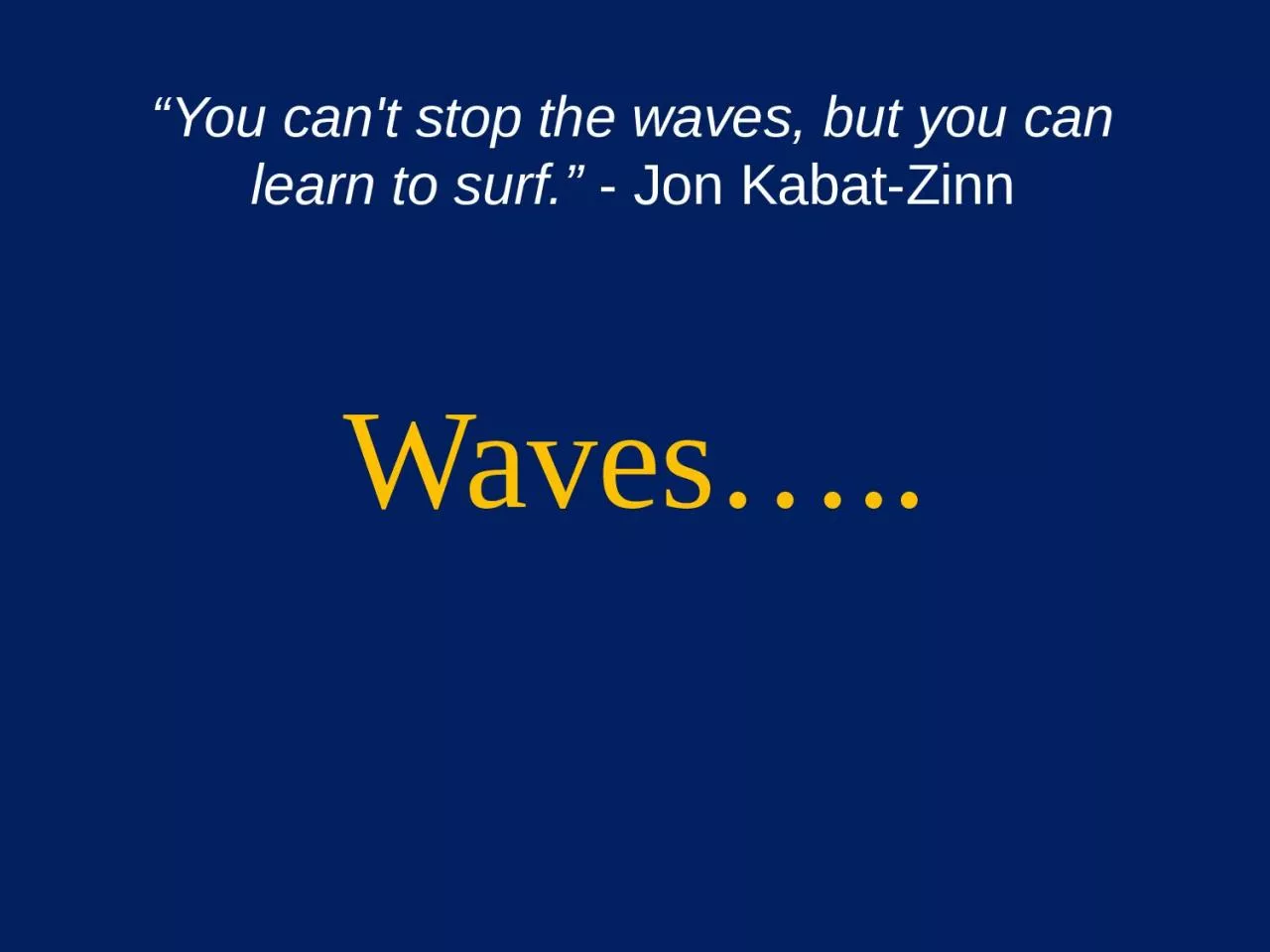

Jon Kabat Zinn Waves are moving energy Most waves winddriven Moving energy along oceanair interface Wind main disturbing force Boundary between and within fluids with different densities ID: 1022804
Download Presentation The PPT/PDF document "Waves….. “You can't stop the waves, ..." is the property of its rightful owner. Permission is granted to download and print the materials on this web site for personal, non-commercial use only, and to display it on your personal computer provided you do not modify the materials and that you retain all copyright notices contained in the materials. By downloading content from our website, you accept the terms of this agreement.
1. Waves…..“You can't stop the waves, but you can learn to surf.” - Jon Kabat-Zinn
2. Waves are moving energy!Most waves wind-drivenMoving energy along ocean/air interface:Wind main disturbing forceBoundary between and within fluids with different densities
3. Air/ocean interface ex. - ocean waves
4. Air/air interface ex. - atmospheric waves
5. Water/water interface ex. - internal waves
6. Other types of wavesSplash waveCoastal landslides, calving icebergs
7. Seismic sea wave or tsunamiSea floor movement
8. Wake ex. Ships
9. TidesGravitational attraction among Moon, Sun, and Earth
10. Let’s Dissect a WaveCrestTroughWave Length (L or λ)Still waterLevelWave Height (H)
11. The distance between crest and trough is a measure of the wave?LengthMagnitudePeriodHeight
12. Wave Period = TThe time it takes for a full wave – or wavelength to pass a fixed position Typically ranges between 6 and 16 seconds
13. Wave Frequency = fNumber of waves passing a fixed location per unittime. It is the inverse of wave period. f= 1/T
14. Types of ocean wavesFig. 8.2
15. Water doesn’t move – only the waveform
16. Wave motionWaves transmit energy Cyclic motion of particles in oceanParticles may moveUp and downBack and forthAround and aroundParticles in ocean waves move in orbital paths
17. 17 Longitudinal Waves (push-pull waves): Particles move back and forth in direction of energy transmission.Energy transmitted by compression and decompression. Energy transmitted through solid, liquid, gas.(www.allrefer.com)
18. 18 Transverse Waves (side-to-side waves):Particles move at right angles to direction of energy transmission.Energy transmitted by vibration.Generally transmits energy through solids
19. Body Waves – bc they transfer energythrough a body of matterSurface Waves – bc they travel btw Two different fluids (air & water); haveCharacteristics of both longitudinal and transverse
20. 20 Particles move in orbital path (both longitudinal and transverse).Energy transmitted along interface between two fluids of different density.Circular orbits of an object floating at the surface have a diameter equal to the wave height.Circular Orbital Motion
21. Wave Base: equal to one half of the wavelength (at SWL) or L/2Only wavelength controls the depth of the wave base…..so the longer the wave the deeper the wave base!
22. Orbital motionDiameter of orbital motion decreases with depth of waterWave base = ½ L (or L/2)Hardly any motion below wave base due to wave activity
23. Water moves with the wave.TrueFalse
24. We describe waves in relation to the depth of the water and their wavelength….Deep-water WavesShallow –water WavesTransitional Wave
25. Wave Base – defined as ½ the wave lengthOr L/2Wave Length (L or λ)
26. Deep-water wavesWater depth is greater than wave base (>1/2L)Ex. – includes all wind generated waves in the open ocean
27. Shallow-water wave (long wave)Water depth is < 1/20LFig. 8.7c
28. Transitional wavesCharacteristics of both deep and shallow-water wavesFig. 8.7bDepth is greater than 1/20 wavelength but less than ½ wavelength
29. Wave SpeedS= wavelength (L)/ period (T)More correctly known as CELERITY –Used only in relation to waves where no mass is in motion, just the wave form.
30. 30When waves meetTwo waves with the same wavelength. In phase: Constructive interference. Out of phase: Destructive interference.
31. 31Mixed interference
32. How do you build a big wave?
33. Three Factors affecting wave height:Wind speedDuration – how long wind blows in one direction. 3. Fetch – distance it blows in one direction.
34. 34Wave DevelopmentWave breaks when steepness (Wave height H / wavelength L) > 1/7.Swells: uniform, symmetrical waves.
35. Wave Steepness= Wave height / WavelengthOr=H/L Or = H/λ
36. Wave Steepness= H/L1/7 Rule…..If the ratio of wave height to wavelength exceeds 1/7 – the wave breaks!Ratio also tells us about maximum wave height….For example – if a wave is 7 m long…. It can only be 1 m high - Otherwise it would break….
37. http://topex-www.jpl.nasa.gov/newsroom/press-releases/images/wind_wave.gif
38.
39.
40. QuizComplete this sentence:Waves are moving _________________.
41. TidesWind WavesTsunamisCapillary